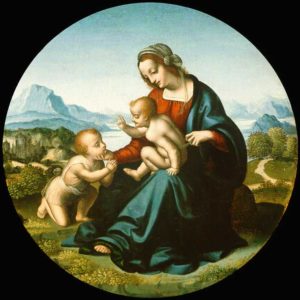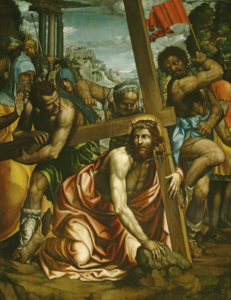Madonna of the Lake (“Madonna del Lago”)
Oil on panel, c. 1520
Marco d’Oggiono
Milanese, 1475-d. 1530
Marco d’Oggiono’s training is not documented with certainty, but he probably worked in the studio of one of the greatest artists who ever lived—Leonardo da Vinci. As such, d’Oggiono did not gain much recognition as an innovator, but rather as a pupil who skillfully learned his master’s style and produced a number of faithful copies. In fact, the composition for this rare panel probably derives from one of da Vinci’s lost paintings and references at least two of the great master’s celebrated works. The poses of both John the Baptist and Christ are found in the Virgin of the Rocks while Mary’s position is based on the Virgin and Child with St. Anne and the Lamb, both by Leonardo and housed in the Louvre.
Among the Leonardesque characteristics evident in this work is the softly shaded modeling on the figures called sfumato. This technique of Leonardo’s invention was inspired by his scientific studies of the effects of light and is used by d’Oggiono to soften the sharp edges of his figures. Consequently, the figural contours subtly dissipate into the natural surroundings to create a unified and harmonious whole. Another interesting motif d’Oggiono borrows from da Vinci is the rocky shelf separating the figures from the view and is found in both the Virgin of the Rocks and the Virgin and Child with St. Anne and the Lamb.
This painting has some very interesting hand-written notes on the reverse made with pen and ink that appear to be fairly old. In the center of the panel is a handwritten note, “Cesare da Sesto, Countess of Harr….” Comparing the partial “Countess of Harr…” with the clearly legible handwritten words ending in “Harrington” in the upper left of the wood panel confirms that a Countess of Harrington once owned the painting. Further research lead to a discovery in an 1857 publication where art critic Gustav Waagen wrote about the painting when it was hanging in the Drawing Room of the Earl of Harrington’s London home, called Harrington House. He said, “Marco Oggione (no. 79): I am in inclined to attribute to this master a small early copy on wood of Leonardo da Vinci’s Madonna del Lago, known by Longhi’s engraving. The head of the Virgin is elevated, and of great power and colour; the two children are less successful.”
The Harringtons sold paintings in 1917 at Christie’s including the Madonna of the Lake. The catalog lists further provenance information as “formerly in the collection at Malmaison.” This was the country chateaux of Napoleon and Josephine Bonaparte. Additional investigation led to the discovery that M&G’s painting was listed in Josephine’s Malmaison inventory when she died in 1814 with a painting by Cesare da Sesto of the Madonna and Child with John the Baptist. Thus, M&G’s painting was once owned by Emperor Napoleon and Josephine!
John M. Nolan, Curator
Published in 2014

